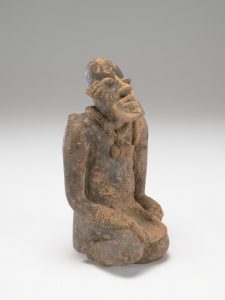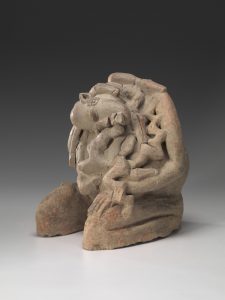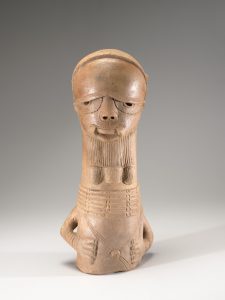
Male Figure, Artist not recorded, Sokoto Region (Nigeria), terracotta. Arthur and Margaret Glasgow Fund, 99.33
By Richard B. Woodward, VMFA Curator of African Art
While ancient Egypt and Kush are well studied and widely known, far less research has been dedicated to the ancient art and history of the rest of the African continent. Recent discoveries across what today is northern Nigeria have opened new chapters regarding the deep history of this important region. From the region of Sokoto State in northwestern Nigeria, terracotta sculptures such as this figure offer evidence of vibrant early civilization and artistic accomplishment. In Africa, terracotta is also used for vessels and building materials, and shards are sometimes used for paving.
The physical properties of fired clay can yield valuable clues about date of manufacture, and thermoluminescence (TL) testing can help establish reliable chronologies. A related post by VMFA Assistant Conservator Ainslie Harrison details the technical aspects of harvesting small amounts of the fired clay for TL testing. Keep reading to gain a broader background about four terracotta sculptures as we await the results of TL testing still to come!
From the Sokoto Region of Nigeria
In northern Nigeria, a waterway system of tributaries to the Niger River in the west and Lake Chad in the east provided an environment conducive for settlement and commerce. In the first half of the 20th century, ancient terracotta sculptures were discovered in the tin-mining region on the Jos Plateau, near the town of Nok. Archaeological investigation has established a timeframe of 1000 BCE to 300 CE for activity in the region, with complex terracotta figure sculptures generally dating from 500 BCE and later. Known as the Nok terracottas, examples in other collections (VMFA does not have any) that have been TL tested confirm the date range established archaeologically.
Nearly 400 miles northwest of Nok, near the confluence of the Sokoto and Rima rivers, terracotta figure sculptures were discovered in 1993. The Sokoto terracottas, as they are called, are characterized by simplified, cylindrical bodies and powerfully modeled heads with heavy eyebrows. The VMFA figure includes six beaded necklaces and a scepter, suggesting that it represents a person of high status.
Sokoto terracottas that have been tested by TL yield comparable dates as works from Nok. By testing this work we anticipate confirming a comparable approximate manufacture date with others from both places, and our results will contribute to knowledge about early development of civilization in these areas. Little in the way of archaeological investigation has been conducted in either location in recent years, so additional clues about ancient societies in this region await disclosure from future excavations.
From the Djenne Region of Mali
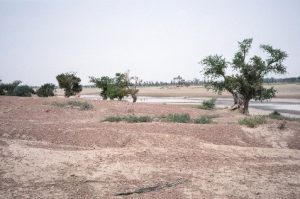
View from ancient Jenne-Jeno, 1992
In Mali, along the edge of the Sahara, the Niger River and its tributary, the Bani, form a broad inland delta some 200 miles long and 40 miles wide. After the rainy season, this floodplain is filled with channels and islands. As the photograph taken from the island site of ancient Jenne-Jeno shows, during the dry season the channels diminish, reconnecting much of the land and leaving small ponds.
Two important cities punctuate the ends of the delta—today’s Djenne, which traces its origins to nearby Jenne-Jeno, and fabled Timbuktu. Beyond Timbuktu, the Niger eventually makes a great bend and flows to the sea, passing not far from Sokoto and eventually emptying into the Atlantic in southern Nigeria, a total distance of more than 2,500 miles.
The Sahara has fluctuated between wetter and dryer conditions over the eons. With the current phase of drying over the past 6,000 years, the Nile and the Niger rivers took on increasing importance for supporting life. The inland delta of the Niger became a crossroad of culture and trade, and Jenne-Jeno along with numerous other island communities in the environs of present day Djenne were active in the first millennium BCE. With the river as their highway, merchants of the two cities traded many goods, key among them exporting gold and importing copper via caravans crossing the Sahara following the introduction of the camel from Arabia in the third century.
Since the mid-20th century, terracotta sculptures have been unearthed in the region, including the kneeling figure (above left) and the complex figure entwined by serpents (above right). For both figures we anticipate that TL testing will suggest a date of manufacture between the 12th and 16th centuries. Further technical examination using equipment made possible by a major grant from the Andrew Mellon Foundation, including new, digital X-rays, will enable us to assemble a more complete and accurate technical analysis regarding the creation and history of these important early works.
From the Akan Kingdoms of Ghana
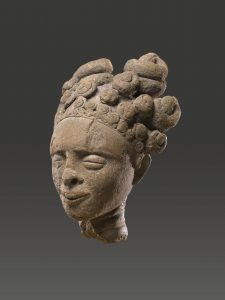
Commemorative Portrait Head, Artist not recorded, Akan Peoples (Ghana), terracotta with traces of polychrome. Arthur and Margaret Glasgow Fund, 88.42
Between the 15th and 19th centuries, the Akan kingdoms controlled commerce based around rich gold deposits in southern Ghana. The gold trade proceeded along both northerly paths via Mali to trans-Saharan routes and to coastal sites for access to the increasing traffic of European seagoing merchants.
Based on matrilineal descent and organized around complex royal courts, Akan nobles commissioned gold regalia, sumptuous textiles, and regal furnishings. Regarding funerary practices for people of courtly rank, female artists created terracotta commemorative heads to house the kra (eternal spirit) of the deceased. Over an extended period of mourning, a commemorative head would be displayed in memorial rites and ultimately installed in a sacred grove. Although the surface of this magnificent head is worn from exposure to the elements, the quality of modeling and elaborate hairdo are exceptional, suggesting that it commemorates a woman of high royal status, perhaps a queen mother.
While not as old as either the Djenne or Sokoto terracotta sculptures above, the results of TL testing will enhance our understanding of its chronological place in Akan history.
